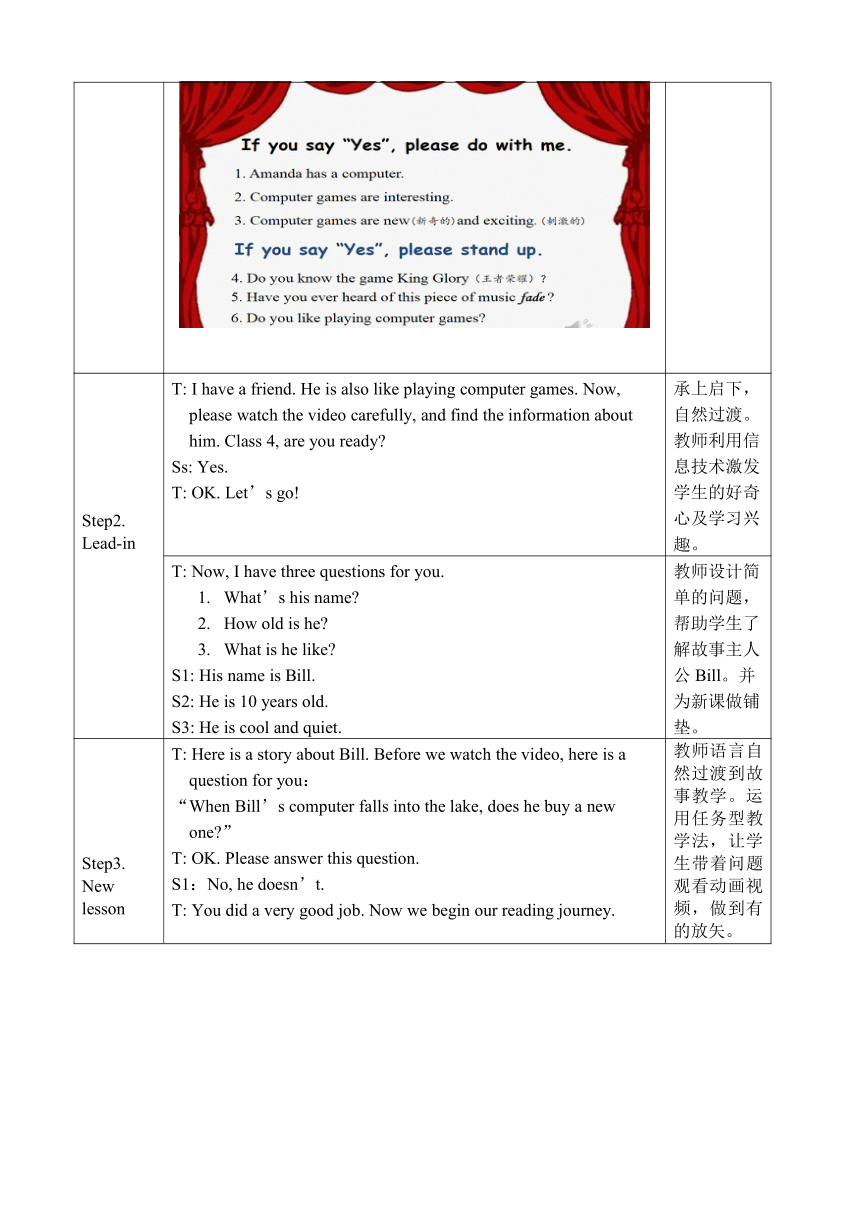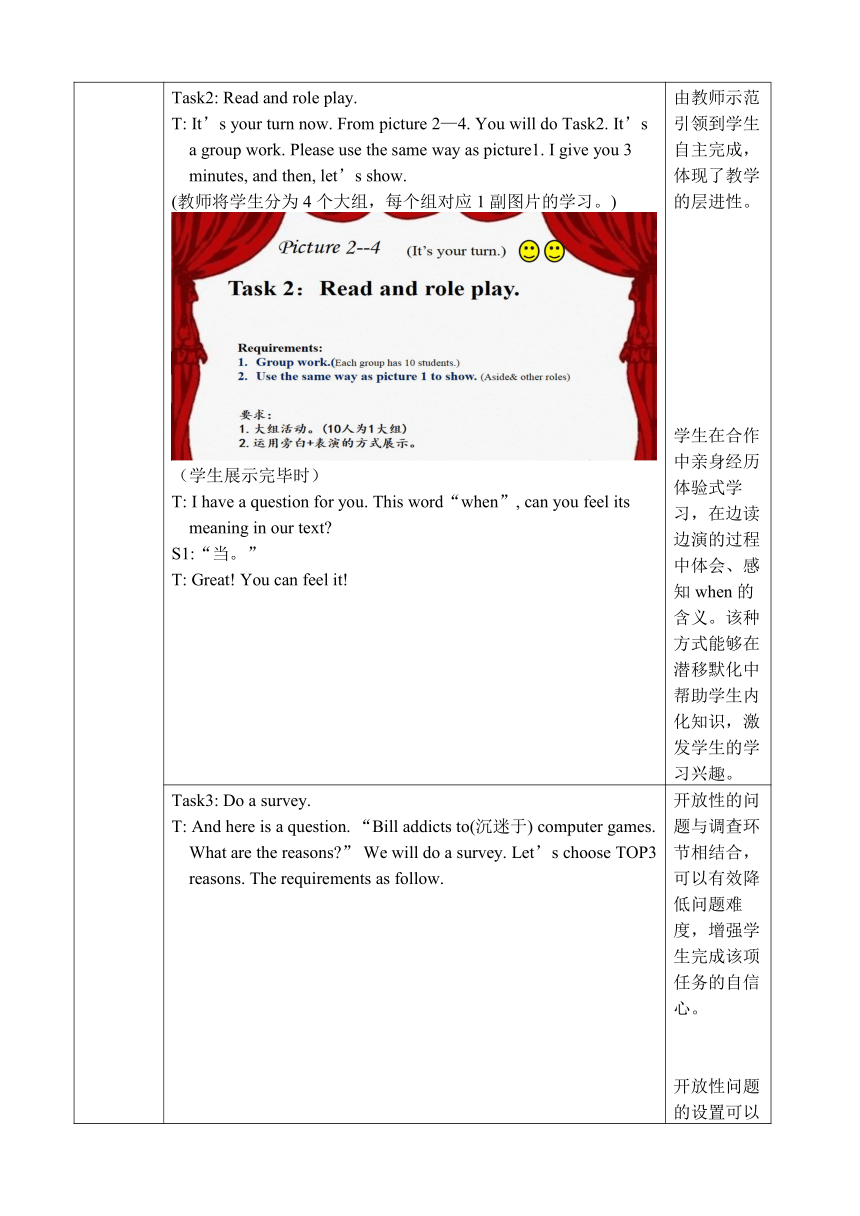Unit2 On the Weekend Story Time 教案(表格式)
文档属性
| 名称 | Unit2 On the Weekend Story Time 教案(表格式) |  | |
| 格式 | doc | ||
| 文件大小 | 5.7MB | ||
| 资源类型 | 教案 | ||
| 版本资源 | 人教(新起点) | ||
| 科目 | 英语 | ||
| 更新时间 | 2022-06-12 09:16:50 | ||
图片预览





文档简介
新起点英语(一年级起点)人教版四年级上册
Unit 2 On the Weekend
第6课时 Story Time 教学设计
【教材分析】
本课选自义务教育课程标准试验教科书,吴欣主编《新起点英语》(一年级起点)人教版教材。本课选自该套教材四年级上册:Unit 2 On the Weekend,第6课时Story Time,故事主要围绕“play computer games”的话题展开,讲述了主人公Bill不论场合、地点,沉迷于电脑游戏。然而,在一次Bill和爸爸去钓鱼的过程中,电脑掉入了河里,从而开启了Bill生活的新篇章。该故事图文并茂,生动有趣且发人深省。故事中涉及的词汇、短语,如:pick fruit、visit one’s grandparents,etc.均已在本单元第1、2课时学习完毕。语言结构有重复:When…Bill plays computer games. 由于本课有大量的图片和语言情境作为支持,学生能够顺利在字里行间体会“when”在故事中的含义。
【学情分析】
本课的教学对象为四年级。他们从一年级开始学习英语,具备一定的语言基础,大部分学生对英语学习有兴趣,乐于用英语表达自己的想法,且此时的学生开始从被动的学习主体向主动的学习主体转变。
教师执教班级的学生,语言基础较良好,他们热爱阅读,善于思考,对英语学习保持着持续的兴趣。结合学生特点,教师设计本课时,注重学生创新精神和实践能力的培养;设计多层次、多角度、开放性的任务贯穿教学始终;教师设置开放性问题,融入批判性思维,重视学生思维能力的培养,启发学生思考、观察和预测,从而更深层次地探究、质疑、分析和评价故事。
【教学目标】
1.能够借助图片和其他阅读策略读懂Story Time的故事,完成故事后的句子排序活动。
2. 能够在教师的指导下表演小故事。
3.能够通过揣测主人公心理,表达对故事的不同看法,逐渐养成爱思考、敢质疑的思维习惯。
4. 通过创编故事等活动展开想象,感受故事学习的乐趣。
5. 多元情感目标的渗透。
【教学重点】
1. 能够读懂并理解故事大意,完成故事后句子排序活动。
2. 能够在教师的指导下表演小故事。
3. 多元情感目标的渗透。
【教学难点】
1.能够通过揣测主人公心理,表达对故事的不同看法,逐渐养成爱思考、敢质疑的思维习惯。
2. 通过创编故事等活动展开想象,感受故事学习的乐趣。
【教学过程】
教学环节 教学活动 设计意图
Step1.Warm-up Greetings. T: Class 4, are you ready for the class Ss: Yes. Ss: Stand up, please.T: Good morning, class.Ss: Good morning, Amanda.T: Sit down please. 师生之间的问候,有助于师生将心收回到课堂。
Let’s chant. 调节课堂气氛,调动学生已有知识储备,为故事学习做铺垫。
TPR Games.T: Now, let’s play a game. I say; you do. Are you ready Ss: Yes. 结合TPR教学法,呈现6个与故事主Computer games相关的问题,为后续环节做准备。
Step2. Lead-in T: I have a friend. He is also like playing computer games. Now, please watch the video carefully, and find the information about him. Class 4, are you ready Ss: Yes.T: OK. Let’s go! 承上启下,自然过渡。教师利用信息技术激发学生的好奇心及学习兴趣。
T: Now, I have three questions for you.What’s his name How old is he What is he like S1: His name is Bill.S2: He is 10 years old.S3: He is cool and quiet. 教师设计简单的问题,帮助学生了解故事主人公Bill。并为新课做铺垫。
Step3.New lesson T: Here is a story about Bill. Before we watch the video, here is a question for you:“When Bill’s computer falls into the lake, does he buy a new one ”T: OK. Please answer this question. S1:No, he doesn’t.T: You did a very good job. Now we begin our reading journey. 教师语言自然过渡到故事教学。运用任务型教学法,让学生带着问题观看动画视频,做到有的放矢。
Task1: Read and role play. T: We will do it together. Now turn to page20. Please read picture one by yourself. I give you 20 seconds.Ss: Bill likes playing computer games. (学生自读图1)T: OK. Time is up. Who wants to be Bill S1、S2、S3……put up hands. (教师挑选3—4名举手的学生扮演Bill)T: We will be asides. Let’s read and act together. (师生一起做旁白)Ss &T: Bill likes playing computer games.T: Super! S1, you are a very good actor! Class 4, do you understand Ss: Yes!T: Good! Now, This group please stand up. You will be Bill. And other students will be asides. Let’s do it together. (此处以大组为单位,进行两组Task1活动) 任务型教学法&体验式教法。教师运“旁白+表演”的方式,让学生在读和表演中感知课文,激发学生的学习兴趣。在任务1中,教师起到示范引领的作用,从点、线、面三个维度关注学生。
Task2: Read and role play.T: It’s your turn now. From picture 2—4. You will do Task2. It’s a group work. Please use the same way as picture1. I give you 3 minutes, and then, let’s show.(教师将学生分为4个大组,每个组对应1副图片的学习。)(学生展示完毕时)T: I have a question for you. This word“when”, can you feel its meaning in our text S1:“当。”T: Great! You can feel it! 由教师示范引领到学生自主完成,体现了教学的层进性。学生在合作中亲身经历体验式学习,在边读边演的过程中体会、感知when的含义。该种方式能够在潜移默化中帮助学生内化知识,激发学生的学习兴趣。
Task3: Do a survey.T: And here is a question. “Bill addicts to(沉迷于) computer games. What are the reasons ” We will do a survey. Let’s choose TOP3 reasons. The requirements as follow.(学生将统计结果呈现在黑板上后) T: Let’s help Bill. What can he do S1: Bill can go to the cinema.T: Good idea!S2: Bill can go to a party.T: Wow, that’s interesting. We will help Bill together. 开放性的问题与调查环节相结合,可以有效降低问题难度,增强学生完成该项任务的自信心。开放性问题的设置可以培养学生思维的宽度和广度;学生以大组为单位进行统计,可以培养学生的合作意识;学生在阅读观察量表时,无形中增加了学生的阅读输入量。
Let’s make up a new chant. 根据任务3的调查结果,以创编chant的方式,再次回到课本,落实到语言知识目标。调查量表环节也体现了情感目标的多元渗透。
T: Let’s come to picture 5. Observe the picture, especially Bill’s face. Please read with emotion.S1: Oh, no! Bill’s computer!T: Wonderful!S2: Oh, no! Bill’s computer!T: Very nice!……T: Let’s read together. 体验式教法,让学生观察Bill的表情,有感情地朗读课文,体会Bill当时的心情,激发学生的学习兴趣。
Critical questionT: Very good! Please observe picture 5 and 6, and I have a question for you:“Is this plot reasonable Why ”Please discuss for 30 seconds, and then, please tell me your answer. You can use Chinese. 结合图片,教师设置批判性问题,有意识培养学生的观察能力、构建学生的批判思维。体现了英语核心素养。
Task4: Role play.T: Here comes Task 4.We will do pair work or group work. Using your imagination, let’s create the real situation.(教师挑选2—3组学生,到讲台前进行汇报表演,每组表演完毕,会予以点评与鼓励。) 结合批判性思维问题,教师设置任务4,意在让学生在“观察—阅读---思考”的基础上,创造性地进行组内汇报表演,培养学生的合作意识和创新精神,体现了英语核心素养。
T: You did an amazing job! Now it’s time to come to our story’s ending. Let’s read silently and then, finish Part B. if you finish it, please sit straight. 回归文本。默读之于学生,是一种非常有效的理解文本的方式。
Step4.Practice T:Now, we will check the answer.S1: Three, five, two, four, one, six.T: If you agree with her/ him, please put up your hands.学生举手。T:Yes, you did a great job! 落实到文本,训练学生阅读理解的技能。
Retell the story.以大组为单位,按照故事发展顺序,和教师一起共同复述故事。 巩固、加深学生对故事的理解。同时,培养学生逻辑思维,提高学生的口语表达能力。
Step5.Extension T:Different choices make different endings. Here we have five new endings.Ways as follows: 情感目标的渗透。教师利用创新的教学方式,打破原有的故事结局,重新构建5个结局。“不同的选择造就不同的结局。”教师将NewEndings设计为一道道可供选择的题目,可以有效降低任务难度。各小组将其选择的结局,粘贴在色卡纸上,制成海报。激发学生的好奇心和学习兴趣。
Task 5T: Here comes to Task 5. 在通读故事过程中,无形中增加了学生的阅读输入量。以小组为单位台前展示,可以增强学生们的自信心,锻炼学生的胆量和语言表达能力。
Blackboard Design
PAGE
Unit 2 On the Weekend
第6课时 Story Time 教学设计
【教材分析】
本课选自义务教育课程标准试验教科书,吴欣主编《新起点英语》(一年级起点)人教版教材。本课选自该套教材四年级上册:Unit 2 On the Weekend,第6课时Story Time,故事主要围绕“play computer games”的话题展开,讲述了主人公Bill不论场合、地点,沉迷于电脑游戏。然而,在一次Bill和爸爸去钓鱼的过程中,电脑掉入了河里,从而开启了Bill生活的新篇章。该故事图文并茂,生动有趣且发人深省。故事中涉及的词汇、短语,如:pick fruit、visit one’s grandparents,etc.均已在本单元第1、2课时学习完毕。语言结构有重复:When…Bill plays computer games. 由于本课有大量的图片和语言情境作为支持,学生能够顺利在字里行间体会“when”在故事中的含义。
【学情分析】
本课的教学对象为四年级。他们从一年级开始学习英语,具备一定的语言基础,大部分学生对英语学习有兴趣,乐于用英语表达自己的想法,且此时的学生开始从被动的学习主体向主动的学习主体转变。
教师执教班级的学生,语言基础较良好,他们热爱阅读,善于思考,对英语学习保持着持续的兴趣。结合学生特点,教师设计本课时,注重学生创新精神和实践能力的培养;设计多层次、多角度、开放性的任务贯穿教学始终;教师设置开放性问题,融入批判性思维,重视学生思维能力的培养,启发学生思考、观察和预测,从而更深层次地探究、质疑、分析和评价故事。
【教学目标】
1.能够借助图片和其他阅读策略读懂Story Time的故事,完成故事后的句子排序活动。
2. 能够在教师的指导下表演小故事。
3.能够通过揣测主人公心理,表达对故事的不同看法,逐渐养成爱思考、敢质疑的思维习惯。
4. 通过创编故事等活动展开想象,感受故事学习的乐趣。
5. 多元情感目标的渗透。
【教学重点】
1. 能够读懂并理解故事大意,完成故事后句子排序活动。
2. 能够在教师的指导下表演小故事。
3. 多元情感目标的渗透。
【教学难点】
1.能够通过揣测主人公心理,表达对故事的不同看法,逐渐养成爱思考、敢质疑的思维习惯。
2. 通过创编故事等活动展开想象,感受故事学习的乐趣。
【教学过程】
教学环节 教学活动 设计意图
Step1.Warm-up Greetings. T: Class 4, are you ready for the class Ss: Yes. Ss: Stand up, please.T: Good morning, class.Ss: Good morning, Amanda.T: Sit down please. 师生之间的问候,有助于师生将心收回到课堂。
Let’s chant. 调节课堂气氛,调动学生已有知识储备,为故事学习做铺垫。
TPR Games.T: Now, let’s play a game. I say; you do. Are you ready Ss: Yes. 结合TPR教学法,呈现6个与故事主Computer games相关的问题,为后续环节做准备。
Step2. Lead-in T: I have a friend. He is also like playing computer games. Now, please watch the video carefully, and find the information about him. Class 4, are you ready Ss: Yes.T: OK. Let’s go! 承上启下,自然过渡。教师利用信息技术激发学生的好奇心及学习兴趣。
T: Now, I have three questions for you.What’s his name How old is he What is he like S1: His name is Bill.S2: He is 10 years old.S3: He is cool and quiet. 教师设计简单的问题,帮助学生了解故事主人公Bill。并为新课做铺垫。
Step3.New lesson T: Here is a story about Bill. Before we watch the video, here is a question for you:“When Bill’s computer falls into the lake, does he buy a new one ”T: OK. Please answer this question. S1:No, he doesn’t.T: You did a very good job. Now we begin our reading journey. 教师语言自然过渡到故事教学。运用任务型教学法,让学生带着问题观看动画视频,做到有的放矢。
Task1: Read and role play. T: We will do it together. Now turn to page20. Please read picture one by yourself. I give you 20 seconds.Ss: Bill likes playing computer games. (学生自读图1)T: OK. Time is up. Who wants to be Bill S1、S2、S3……put up hands. (教师挑选3—4名举手的学生扮演Bill)T: We will be asides. Let’s read and act together. (师生一起做旁白)Ss &T: Bill likes playing computer games.T: Super! S1, you are a very good actor! Class 4, do you understand Ss: Yes!T: Good! Now, This group please stand up. You will be Bill. And other students will be asides. Let’s do it together. (此处以大组为单位,进行两组Task1活动) 任务型教学法&体验式教法。教师运“旁白+表演”的方式,让学生在读和表演中感知课文,激发学生的学习兴趣。在任务1中,教师起到示范引领的作用,从点、线、面三个维度关注学生。
Task2: Read and role play.T: It’s your turn now. From picture 2—4. You will do Task2. It’s a group work. Please use the same way as picture1. I give you 3 minutes, and then, let’s show.(教师将学生分为4个大组,每个组对应1副图片的学习。)(学生展示完毕时)T: I have a question for you. This word“when”, can you feel its meaning in our text S1:“当。”T: Great! You can feel it! 由教师示范引领到学生自主完成,体现了教学的层进性。学生在合作中亲身经历体验式学习,在边读边演的过程中体会、感知when的含义。该种方式能够在潜移默化中帮助学生内化知识,激发学生的学习兴趣。
Task3: Do a survey.T: And here is a question. “Bill addicts to(沉迷于) computer games. What are the reasons ” We will do a survey. Let’s choose TOP3 reasons. The requirements as follow.(学生将统计结果呈现在黑板上后) T: Let’s help Bill. What can he do S1: Bill can go to the cinema.T: Good idea!S2: Bill can go to a party.T: Wow, that’s interesting. We will help Bill together. 开放性的问题与调查环节相结合,可以有效降低问题难度,增强学生完成该项任务的自信心。开放性问题的设置可以培养学生思维的宽度和广度;学生以大组为单位进行统计,可以培养学生的合作意识;学生在阅读观察量表时,无形中增加了学生的阅读输入量。
Let’s make up a new chant. 根据任务3的调查结果,以创编chant的方式,再次回到课本,落实到语言知识目标。调查量表环节也体现了情感目标的多元渗透。
T: Let’s come to picture 5. Observe the picture, especially Bill’s face. Please read with emotion.S1: Oh, no! Bill’s computer!T: Wonderful!S2: Oh, no! Bill’s computer!T: Very nice!……T: Let’s read together. 体验式教法,让学生观察Bill的表情,有感情地朗读课文,体会Bill当时的心情,激发学生的学习兴趣。
Critical questionT: Very good! Please observe picture 5 and 6, and I have a question for you:“Is this plot reasonable Why ”Please discuss for 30 seconds, and then, please tell me your answer. You can use Chinese. 结合图片,教师设置批判性问题,有意识培养学生的观察能力、构建学生的批判思维。体现了英语核心素养。
Task4: Role play.T: Here comes Task 4.We will do pair work or group work. Using your imagination, let’s create the real situation.(教师挑选2—3组学生,到讲台前进行汇报表演,每组表演完毕,会予以点评与鼓励。) 结合批判性思维问题,教师设置任务4,意在让学生在“观察—阅读---思考”的基础上,创造性地进行组内汇报表演,培养学生的合作意识和创新精神,体现了英语核心素养。
T: You did an amazing job! Now it’s time to come to our story’s ending. Let’s read silently and then, finish Part B. if you finish it, please sit straight. 回归文本。默读之于学生,是一种非常有效的理解文本的方式。
Step4.Practice T:Now, we will check the answer.S1: Three, five, two, four, one, six.T: If you agree with her/ him, please put up your hands.学生举手。T:Yes, you did a great job! 落实到文本,训练学生阅读理解的技能。
Retell the story.以大组为单位,按照故事发展顺序,和教师一起共同复述故事。 巩固、加深学生对故事的理解。同时,培养学生逻辑思维,提高学生的口语表达能力。
Step5.Extension T:Different choices make different endings. Here we have five new endings.Ways as follows: 情感目标的渗透。教师利用创新的教学方式,打破原有的故事结局,重新构建5个结局。“不同的选择造就不同的结局。”教师将NewEndings设计为一道道可供选择的题目,可以有效降低任务难度。各小组将其选择的结局,粘贴在色卡纸上,制成海报。激发学生的好奇心和学习兴趣。
Task 5T: Here comes to Task 5. 在通读故事过程中,无形中增加了学生的阅读输入量。以小组为单位台前展示,可以增强学生们的自信心,锻炼学生的胆量和语言表达能力。
Blackboard Design
PAGE
同课章节目录
